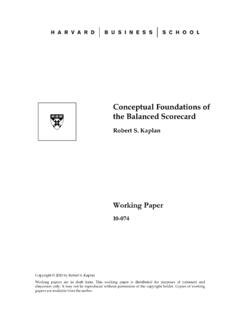Transcription of The Impact of Employee Engagement on Performance
1 A report by harvard business review analytic servicesThe Impact of Employee Engagement on PerformanceSponsored bythe Impact of Employee Engagement on Performance | 1 Executive SummaryEmployee Engagement has become a top business priority for senior executives. In this rapid cycle economy, business leaders know that having a high-performing workforce is essential for growth and survival. They recognize that a highly engaged workforce can increase inno-vation, productivity, and bottom-line Performance while reducing costs related to hiring and retention in highly competitive talent markets. But while most executives see a clear need to improve Employee Engagement , many have yet to develop tangible ways to measure and tackle this goal. However, a growing group of best-in-class companies says they are gaining competitive advantage through establishing metrics and practices to effectively quantify and improve the Impact of their Engagement initiatives on overall business Performance .
2 These are among the findings of a new harvard business review Analytic Services report of more than 550 executives around Employee Engagement research that features in-depth interviews with 12 best-practice company leaders. The research found that while most leaders understand the importance of Engagement , three-quarters of those surveyed said that most employees in their organizations are not highly engaged. A significant gap showed up in the views of executive managers and middle managers in this area. Top executives seemed much more optimistic about the levels of Employee Engagement in their company, making them seem out of touch with middle man-agement s sense of their frontline workers survey found that many companies find it challenging to measure Engagement and tie its Impact to financial results: fewer than 50 percent of companies said that they are effec-tively measuring Employee Engagement against business Performance metrics such as cus-tomer satisfaction or increased market one group of companies called high prioritizers in the study because they saw Engagement as an extremely important priority are effectively using metrics and shared some best practices for tying Engagement to business Performance .
3 Copyright 2013 harvard business School Publishing. All rights Impact of Employee Engagement on Performancehighlights71%of respondents rank Employee Engagement as very important to achieving overall organizational %of respondents rank recognition given for high performers as having a significant Impact on Employee of respondents say employees in their organization are highly | a harvard business review analytic services reportThese include: Avoiding rote surveys. Leading companies devote significant resources to carefully crafting Employee Engagement surveys so they ask pointed, clear questions that go beyond measuring satisfaction. They then pore through the data to find the hidden stories of what s working and where there are pockets of dissatisfaction. Finally, senior management uses this information to inform strategy and policies going forward. Ensuring that goal alignment is occurring at every level of the organization and is well-communicated.
4 Top managers set and communicate business objectives; middle managers are responsible for creating specific objectives for employees that support broader business goals; and employees are given the tools to succeed, some autonomy, and accountability to meet tangible goals aligned with corporate goals. Using data to leverage Engagement initiatives to improve Performance , typically customer satisfac-tion/net promoter score (NPS) surveys and feedback, and then tying winning results to recognition programs to reinforce alignment and the activities linked to Performance . In most companies, today s leaders are acutely aware that there is much to be done to ensure that they have a focused and highly engaged workforce. Connecting Engagement to business Performance requires considerable effort and top management focus and, to a large degree, it is about how you do it. But there is enormous opportunity for companies that get it right. Respondent snapshot (Methodology)A total of 568 respondents completed the survey.
5 All were from organizations with 500 or more employees; more than 42 percent of respondents were from organizations of 10,000 or more employees. The survey was global, representing companies with headquarters in North America (54 percent), Asia (18 percent), Europe (16 percent), MEA (7 percent), and South/Central America (5 percent). The respondents were from a variety of industries: 16 percent worked in IT/telecommunications firms; 14 percent were from financial services; 12 percent were in manufacturing; 9 percent were in energy/utilities; 8 percent were in healthcare and 8 percent were in education; and other sectors made up the remaining 33 respondents were largely senior-level executives: 15 percent are executive management or board members; 32 percent are senior management; 35 percent are middle management; and the remaining 18 percent are other grades. The largest percentage, 27 percent, manages a group of people within a department, while 24 percent have people management responsibility for the whole department.
6 Fourteen percent have people management responsibility for their whole business unit, and 13 percent extend the responsibility corporate-wide. the Impact of Employee Engagement on Performance | 3 Figures 1 and 2 Lowering costs Investing for growth Both Neither31%51%16%2%Shifting Strategy: Companies Are Now Investing in GrowthWould you say your organization s primary focus over the past three years has been on lowering costs or investing for growth? What is your organization s primary focus for the year ahead? PRIMARY business FOCUS, PAST THREE YEARS PRIMARY business FOCUS, YEAR AHEAD27%47%24%2%full reportThe Importance of Employee Engagement As companies emerge from the recessionary economic climate of the past three years, there has been a shift toward investing for growth and away from cost reduction. Twenty-four percent now say they are investing for growth in the coming year, while only 16 percent said they were doing this over the past three years, representing a significant shift toward investment.
7 Many companies, though, are hedging their bets, cautiously entering growth mode while still maintaining a rigorous focus on cost containment. figures 1 and 2 Given this renewed emphasis on growth and investment, which factors do business leaders view as most critical to success? People-oriented soft factors dominate this list. The top three success factors identi-fied in this study were achieving a high level of customer service, effective communications, and achiev-ing a high level of Employee Engagement and strong executive leadership (tied for third place). This places Employee Engagement as a top-three business priority. figure 3 This is not surprising. For the past several years, companies have been increasingly monitoring their Engagement levels, as a growing body of research has demonstrated that having a highly engaged work-force not only maximizes a company s investment in human capital and improves productivity, but it can also significantly reduce costs, such as turnover, that directly Impact the bottom line.
8 Mike Rickheim, vice president of talent management at Newell Rubbermaid, a global consumer goods company, explained that Engagement is not just a warm, fuzzy thing. It s about giving people the tools they need to succeed in their careers, which in turn drives the outcomes that we re seeking in the market-place. When you look at it through that lens, when people have the tools they need to succeed, feel good about their personal growth opportunities, and receive the appropriate rewards and recognition for their contributions, it s a win-win proposition. 4 | a harvard business review analytic services reportFigure 3 Factors Most Likely to Bring Success Which factors are most likely to bring success?Importance top box scores (8 10) for all respondentsHigh level of customer service80%High level of Employee engagement71%Strong executive leadership71%73 %Effective communicationsEfficient productivity68%Ability to innovate59%Strong sales and marketing capabilities58%59%Continuous quality improvementHigh and Low Prioritizers What Sets Them ApartTo understand how best-in-class companies connect Employee Engagement to business Performance , the study asked participants to rate how important Employee Engagement is to overall organizational success using a 1-10 scale where 1 means not at all important and 10 signifies extreme importance.
9 Based on their responses, participants were then divided into one of three categories: low prioritizers, moderate prioritizers, and high prioritizers. The low prioritizers, 14 percent of the total respondents, placed a low value on Employee Engagement (2-6). The moderate prioritizers, at 38 percent, put Employee Engagement at a 7 or 8. The high prioritizers, 48 percent of those surveyed, gave Employee Engagement a 9 or 10. The rest of the survey tracked respondents based on these categories. Some interesting correlations and contrasts emerged between high and low prioritizers. Low prioritizers were much more likely to focus on cost cutting vs. investment (43 percent) and are more likely to be middle managers within an operations or product management function. High prioritizers, meanwhile, were senior managers who placed greater value on other success factors: 94 percent believed high levels of customer service are important to achieving business success, compared to 39 percent of low prioritizers.
10 Figure 4 When asked how optimistic respondents were in their ability to create value in the coming year, high pri-oritizers were far more bullish than were low prioritizers: Nearly half of high prioritizers (44 percent) said they were well-positioned to create value, while only 21 percent of low prioritizers believed they were. figure 5the Impact of Employee Engagement on Performance | 5 Figure 5 Ability to Create Value in Coming YearHow well-positioned is your organization to create value for customers and shareholders in the year ahead? Well-positioned (8 10)38%44%39%21% Low prioritizers Moderate prioritizers High prioritizers All Figure 4 Engagement : High Prioritizers More Likely to Value Success Factors How important are each of the following in achieving overall organizational success? High level of customer service78%39%94%71%31%86%67%31%85%62%38% 81%51%24%76 %54%26%73 %56%28%68%Effective communicationsStrong executive leadershipEfficient productivityContinuous quality improvementAbility to innovateStrong sales and marketing capabilities High prioritizers Moderate prioritizers Low prioritizers 6 | a harvard business review analytic services reportFigure 6 Current Levels of Employee EngagementWhich of the following do you feel best describes the level of Employee Engagement in your organization?








